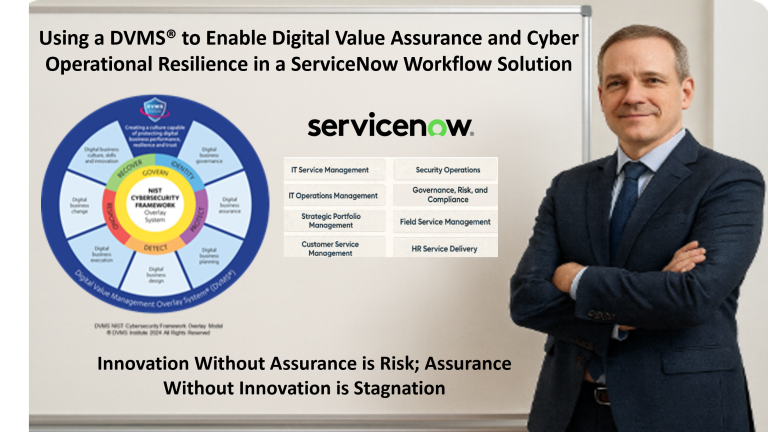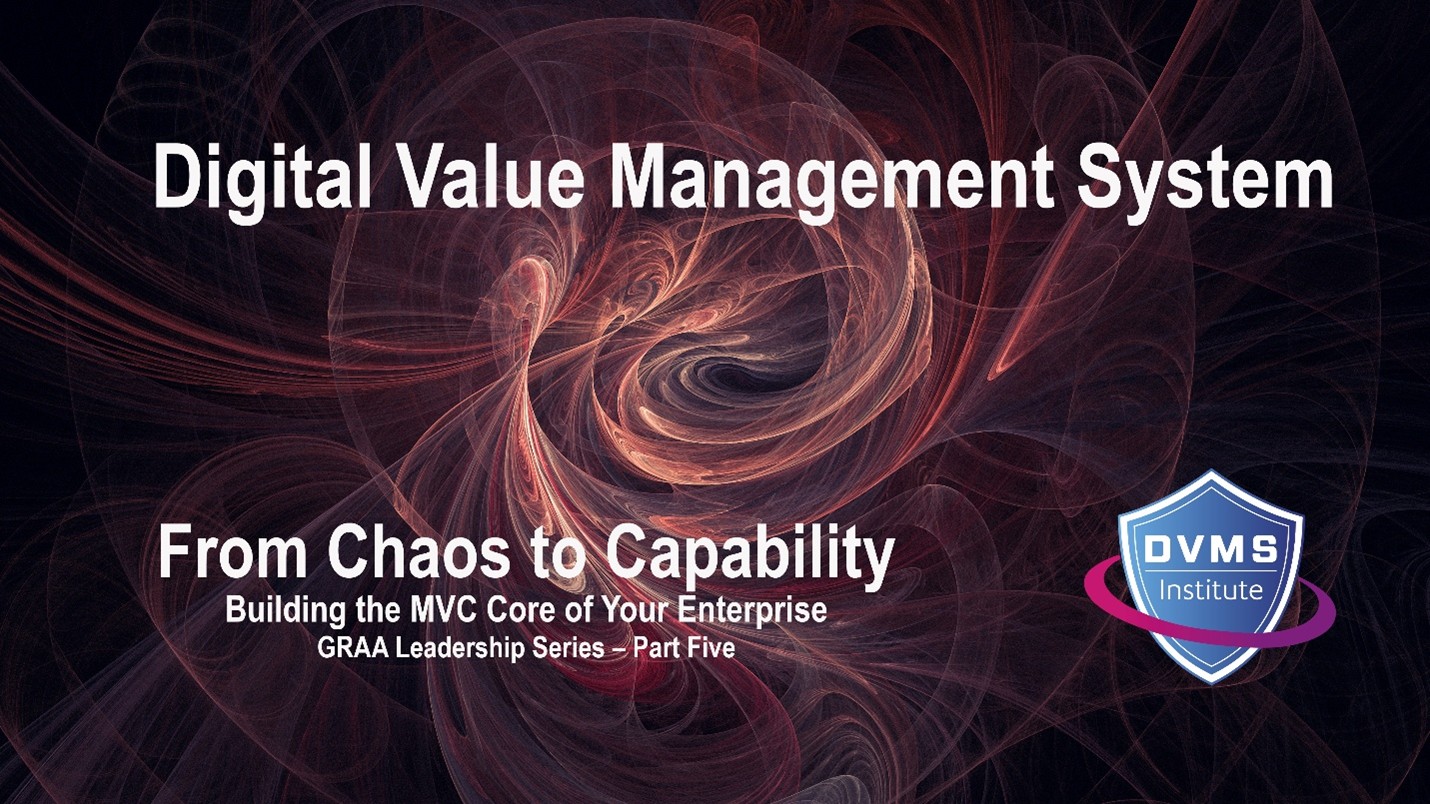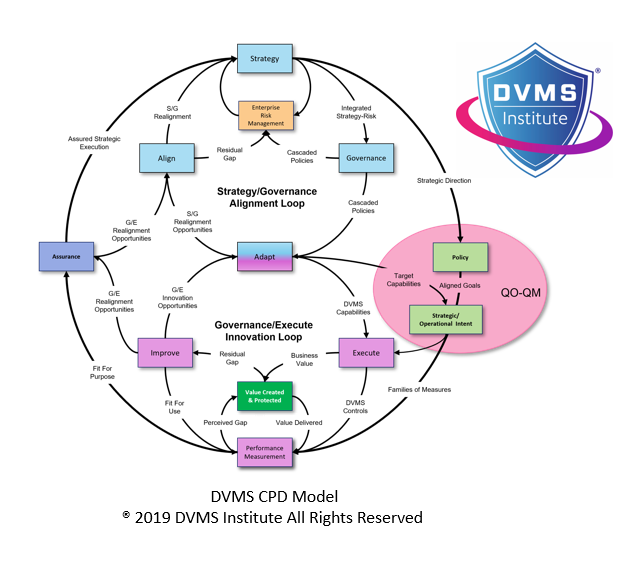Using a DVMS® to Enable Digital Value Assurance and Operational Resilience in a ServiceNow Workflow Solution
Rick Lemieux – Co-Founder and Chief Product Officer of the DVMS Institute
In today’s volatile, uncertain, complex, and ambiguous (VUCA) digital environment, ensuring resilient and assured business outcomes across enterprise platforms like ServiceNow requires more than cybersecurity controls. Organizations need an integrated system to unify strategic objectives, operational execution, governance, and culture. The Digital Value Management System® (DVMS) provides that integration. It acts as a systems-based overlay that adapts to any existing framework or technology stack to transform digital capabilities into secure, resilient, and performance-assured business value across ServiceNow’s ITSM, ITOM, ITAM, HSRD, SecOps, GRC, CSM, FSM, and DevOps workflow solutions.
From Siloes to Systemic Resilience: The DVMS Overlay
The DVMS is not a framework or methodology—it is a scalable, adaptable overlay that extends what organizations already do. It integrates existing tools, processes, and frameworks and maps them against a holistic system of minimum viable capabilities (MVCs): Govern, Assure, Plan, Design, Change, Execute, and Innovate. These capabilities align with and enable risk-informed decision-making across all layers of an enterprise’s digital ecosystem.
When applied across ServiceNow modules, the DVMS acts as a strategic “lens” that aligns each module’s outcomes with organizational goals. For example, in ITSM and ITOM, DVMS ensures governance-driven incidents, problems, and change management practices are compliant and value-generating. ITAM provides asset lifecycle practices to support risk and cost optimization. In HSRD, DVMS embeds governance, assurance, and continuous improvement into HR workflows aligned with organizational strategy and compliance requirements. This systemic overlay prevents siloed decision-making, enabling cross-module coordination rooted in shared governance and assurance principles.
Strategic Governance with Embedded Assurance
DVMS starts with strategic intent. Its “Govern” and “Assure” MVCs drive policy alignment, risk thresholds, and performance measurement that cascade from leadership to operations. This governance cascade is critical across ServiceNow’s GRC and SecOps modules. In GRC, DVMS ensures controls, policies, and risk registers reflect enterprise priorities rather than isolated departmental concerns. In SecOps, DVMS ties incident response and threat intelligence to broader governance imperatives like board-level risk tolerance or regulatory exposure.
This top-down clarity provides a unified vision across ServiceNow’s business modules. For example, customer experience management (CSM) and field service (FSM) traditionally operate independently of cyber governance. Through DVMS, both can integrate customer trust metrics, SLA risk impact, and operational assurance indicators into their workflows. The result is that risk management becomes not just a cybersecurity task, but a business performance enabler.
Culture as a Lever: Driving Systemic Adaptability
A foundational principle of the DVMS is that structure and behavior are intertwined; culture must be deliberately shaped to support resilience and performance. In complex adaptive systems (CAS) like digital enterprises, small changes in structure or culture can produce outsized impacts. The DVMS acknowledges this and offers mechanisms to morph culture using models like the Cultural Web. This includes influencing stories, rituals, decision-making, and control systems to instill a risk-aware, learning-driven culture.
This cultural leverage is especially critical across agile and DevOps teams. DVMS aligns DevOps practices to organizational values such as transparency, experimentation, and accountability. It empowers autonomous teams while ensuring they are guided by the same “Create and Protect” ethos. DVMS transforms CI/CD pipelines from velocity-only machines into resilient, secure value delivery engines as applied to ServiceNow’s DevOps integrations. Developers become risk participants, not just code contributors.
Operational Integration Across the Digital Ecosystem
Operationalizing cyber-resilient outcomes requires more than policies and training—it requires systematized execution. DVMS’s “Plan,” “Design,” “Change,” and “Execute” capabilities deliver this. They integrate governance objectives into workflows, change initiatives, and service design efforts, all of which are central to ServiceNow’s ITOM, ITSM, and ITAM functionality.
For instance, the Plan capability connects ServiceNow’s portfolio and project management tools to organizational cyber strategy and risk profiles. This ensures business initiatives are launched with defined risk tolerances and expected assurance levels. The Design and Change capabilities shape how ITSM and ITAM services are architected and modified to uphold resilience principles—reducing tech debt, eliminating fragile configurations, and institutionalizing change control. Meanwhile, Execute ensures frontline activities—whether responding to a ticket in FSM or fulfilling a request in HSRD—are consistent with broader digital trust mandates.
Enabling Continuous Learning and Innovation
Innovation without assurance is risk; assurance without innovation is stagnation. The DVMS closes this dichotomy by embedding “Innovate” as a core capability. Organizations must continuously evolve their cyber and digital capabilities. In the context of ServiceNow’s platform, DVMS encourages organizations to treat innovation—such as AI-powered chatbots in CSM or predictive analytics in ITOM—not as side projects but as intentional, risk-informed enhancements to value creation and protection.
DVMS also promotes learning through retrospectives, after-action reviews, and decision analysis. For instance, in ITSM, problem management isn’t just a way to fix root causes—it’s a method for institutional learning. By structuring lessons learned into governance feedback loops, DVMS ensures ServiceNow modules are not static systems but continuously adapting, improving, and aligning with business goals.
Interconnected Outcomes: The DVMS Model in Action
What makes DVMS powerful is its recognition that digital business success is not defined by technology alone but by a system of systems—people, processes, and platforms—working in harmony. The DVMS 3D Knowledge Model exemplifies this by showing how teams must understand not only what they are doing (X-axis) but also how it connects to others (Y-axis) and aligns with organizational intent (Z-axis).
When DVMS is used across ServiceNow’s suite, each module contributes to a shared system: ITSM supports continuity, GRC manages compliance, SecOps ensures responsiveness, and CSM delivers trust—all bound together by adaptive governance, enabled through culture, and empowered by systemic learning. The result is a digital enterprise that doesn’t just respond to cyber threats but thrives on the edge of chaos.
Conclusion: A System for Assured, Resilient Digital Value
The DVMS equips organizations with a systemic overlay to transform chaos into resilience and strategy into execution. By integrating governance, culture, risk, and assurance into the DNA of operations across ServiceNow’s digital business modules, the DVMS enables organizations to deliver trustworthy, resilient, and adaptive outcomes. In a world of constant threats and rising expectations, the DVMS ensures digital value is created, appropriately protected, and sustained.
About the Author

Rick Lemieux
Co-Founder and Chief Product Officer of the DVMS Institute
Rick has 40+ years of passion and experience creating solutions to give organizations a competitive edge in their service markets. In 2015, Rick was identified as one of the top five IT Entrepreneurs in the State of Rhode Island by the TECH 10 awards for developing innovative training and mentoring solutions for boards, senior executives, and operational stakeholders.
In today’s digitally driven economy, cyber disruptions are no longer an “if” but a “when.”
The DVMS Institute’s Certified Training Programs teach organizations the skills to build a Holistic and Culture-Aligned Overlay System capable of coordinating Cyber Operational Resilience actions across a Complex Digital Ecosystem.
Achieving true cyber operational resilience requires seamless alignment between organizational Strategy, Governance, and Operations, underpinned by a culture dedicated to sustaining and continuously innovating the Creation, Protection And Delivery of organizational digital value.

The DVMS positions cyber resilience as a strategic, enterprise-wide capability powered by your best practice systems (NISTCSF, ITSM, GRC etc.) and the DVMS MVC, CPD, and 3D Knowledge models.
This systems-based approach to cyber operational resilience demands active engagement from all members of the Digital Ecosystem. Each member plays a distinct role in proactively identifying and mitigating the systemic risks that threaten digital business operations.
This forward-looking approach to adaptive Governance, Resilience, and Assurance (GRA) positions businesses to:
- Maintain Operational Stability Amidst Constant Digital Disruption
- Drive Agility and Trust Across Your Digital Ecosystem
- Satisfy Critical Regulatory and Certification Requirements
- Leverage Cyber Resilience as a Competitive Advantage
DVMS Explainer Videos
- Architecture Video: David Moskowitz explains the DVMS System
- Case Study Video: Dr. Joseph Baugh Shares His DVMS Story.
- Overlay Model – What is an Overlay Model
- ZX Model – The MVC’s that power operational resilience
- CPD Model – Adaptable governance and assurance
- 3D Knowledge Model – Enabling holistic organizational learning
- FastTrack Model – A phased approach to cyber resilience
Digital Value Management System® is a registered trademark of the DVMS Institute LLC.
® DVMS Institute 2025 All Rights Reserved




